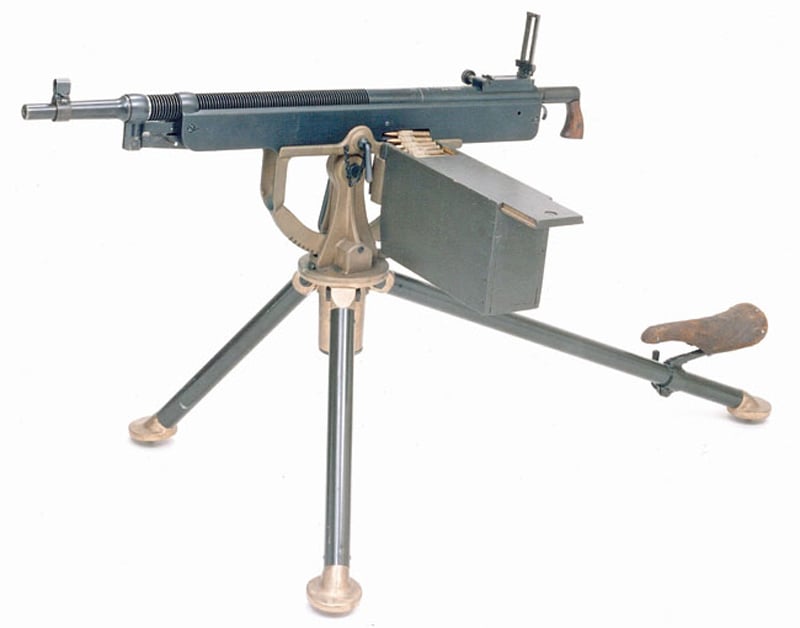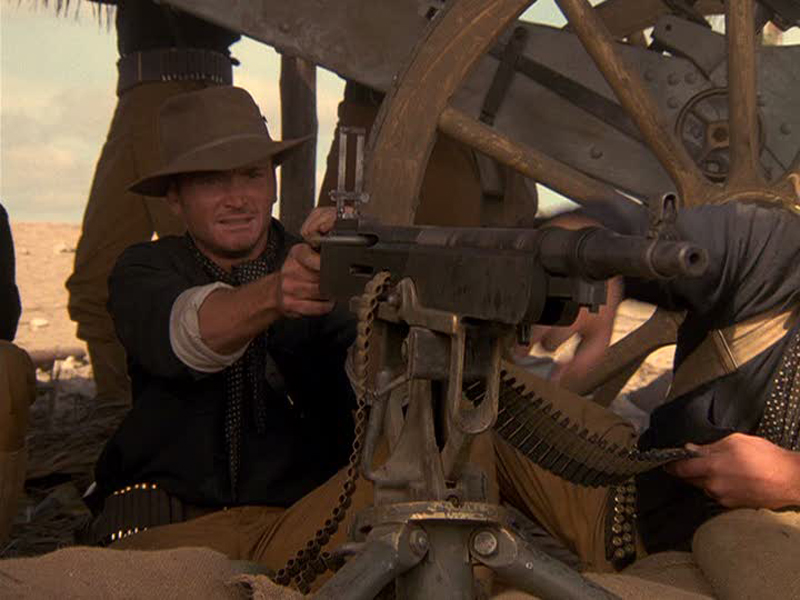President Joe Biden has repeatedly suggested when it was first drafted there were restrictions to the Second Amendment. He pressed the point by stating that “you couldn’t own a cannon,” while more recently he’s made the argument that the Second Amendment isn’t absolute in that Americans today can’t own a machine gun.
The president is of course wrong on both counts.
First, numerous media outlets have fact-checked Biden on the former point and reported that cannons were, in fact, legal to own, and were commonly employed on civilian merchant ships in the late 18th century. Most Americans simply didn’t own cannons because there was little reason to have one. As for the second point, Biden is also wrong — and today, residents in 37 states can legally own a machine gun if they go through the process of doing a transfer with the National Firearms Act (NFA) branch of the ATF.
More importantly, there was a time when machine guns were marketed to consumers. That included famously the Thompson submachine gun, which was pitched to ranchers in the 1920s, but in fact, one of the very first American-produced machine guns was also offered for sale to civilians.
John Browning’s First Machine Gun
While firearms designer Hiram Maxim took his invention to Europe, prolific designer John Browning and his brother Matthew developed the Colt-Browning M1895 machine gun from an early patent for automatic rifles, which Colt offered to the U.S. military.

The design proved to be the first successful gas-operated machine gun.
Nicknamed the “potato digger” due to its unusual operating mechanism, it was a gas-operated, air-cooled belt-fed firearm that fired from a closed bolt. It had a cyclic rate of 450 rounds per minute, at a time when most soldiers were lucky to be armed with bolt action rifles.
It went on to be the first machine gun adopted by the U.S. military, serving with both the United States Navy and the United States Marine Corps. However, as the U.S. Army was still barely more than a token force at the end of the 19th century, and its leaders were still pleased with its hand-cranked Gatling Guns, its leadership passed on the weapon — with some in the Ordnance Corps seeing it as a fad.
The U.S. Army Ordnance Board reviewed the weapon, noted its benefits, but then rejected it.
“The board is of the opinion that in its present form, as shown by the tests made this arm is not suitable for ordinary service and has no place in the land armament,” the Ordnance Board responded. It was shortsighted, but military thinkers have long failed to embrace innovation.

Finding a Buyer
Colt was deterred and instead attempted to find foreign buyers, and it found interest in such distant lands as Imperial Russia, but it also wasn’t averse to selling its firearms to civilians. The fact was that like cannons, there simply wasn’t a great deal of interest at the time for a machine gun.
Had the Colt-Browning M1895 arrived even a decade earlier, it might have found a place on the railroads or perhaps stagecoaches crossing the plains. But by the time the weapon arrived on the scene, the frontier was essentially “closed” — as the Census Bureau announced in 1890 that there were no apparent tracts of lands without settlers.
The machine gun simply didn’t seem to have a place in the civilized world.

Yet, the M1895 appeared in Colt’s dealer catalogs, though the prices aren’t listed. It is known that in 1862, a Gatling Gun cost around $1,500 — a significant sum, and equal to around $55,000 in 2023 dollars!
It is also unclear how many Colt-Browning M1895s were sold to consumers, but there is ample evidence that at least two were “privately purchased” — and those guns have become something of infamy but also misunderstanding.
The Tiffany Guns
During the Spanish-American War, the 1st United States Volunteer Cavalry became one of three such regiments raised after President William McKinley responded to the sinking of the USS Maine in Havana, Cuba, by calling for 125,000 volunteers. At the time, the U.S. Army was small, understaffed, and largely disorganized — and it needed volunteers to bolster its ranks.
Thus this colorful regiment was formed under the command of Colonel Leonard Wood, while its second in command was former Assistant Secretary of the Navy Theodore Roosevelt. When Wood was promoted to become commander of the 2nd Cavalry Brigade, the unit became known as “Roosevelt’s Rough Riders” — borrowing the name from Buffalo Bill’s Wild West and Congress of Rough Riders of the World.
The unit attracted volunteers from Arizona, New Mexico, Oklahoma, and Texas — and it is remembered for it being made up of cowboys, gold miners, hunters, gamblers, and Native Americans. Despite the rugged persona that he later crafted as president, Roosevelt was none of the above. Though he ran a ranch in the Dakotas, he was a Harvard-educated politician, and he successfully convinced a number of his East Coast socialite friends and Ivy League athletes to join him for what promised to be a grand adventure!
Being a volunteer unit, even one that had some “connections” thanks to Roosevelt, the Rough Riders struggled to obtain the proper equipment. But the Rough Riders were also armed with something special — a pair of those Colt-Browning M1895 machine guns!
These were privately purchased and have become known as the “Tiffany Guns,” and numerous sources have suggested these were gifted by Louis Tiffany, the owner of the famous Tiffany & Company luxury retailer on Manhattan’s Fifth Avenue. The story sounds almost too good to be true, a Tiffany machine gun was used by Teddy Roosevelt’s Rough Riders!
Well, sorry to disappoint, but the Tiffany & Company part of the story is wrong.

It is true that Roosevelt was joined by his friend William Tiffany, who was promoted to Sergeant for his abilities to shoot and ride, but William wasn’t the son of Louis Tiffany. However, the misunderstanding isn’t surprising as Smith & Wesson produced a decorated revolver with an elaborate art nouveau-style silver grip that was the result of a collaboration with the famous jeweler. It was made for the 1893 Columbian exhibition in Chicago and was quite the departure for S&W, which typically employed its own in-house engravers.
A Different Tiffany Connection
Though Tiffany & Company may have worked with S&W, the jeweler and its founder had nothing to do with purchasing the M1895 machine guns. Louis Tiffany had eight children, including two sons but neither was Roosevelt’s close friend.
As the NRA’s “American Rifleman” noted, William Tiffany was the son of Newport, Rhode Island, scions George and Isabella Tiffany. However, his father George certainly couldn’t have donated the guns to the unit as he died in 1886.
In actuality, William Tiffany — the grand-nephew of Col. Oliver Hazard Perry — and his two older sisters paid for one of the two machine guns, while the second was purchased by Louisa Langdon Kane and Sybil Kent Kane, the older sisters of Captain Woodbury Kane, a friend of Roosevelt’s from Harvard and the great-grandson of John Jacob Astor.
However, the 1999 TNT original miniseries “The Rough Riders” has served to contribute to the myth that both guns were purchased by William Tiffany’s family. The script stated that the two Model 1895s were a gift from Charles Lewis Tiffany!

What the film did get is that William Tiffany was made sergeant of the Rough Rider’s machine gun detachment. Buying, or convincing others to pay for, the pair of machine guns may have contributed to that appointment.
The First U.S. Army Machine Gun to See Service
Both of the privately purchased weapons were used in the charge of San Juan Hill, which is also notable as the U.S. Army was still employing its Gatling Guns during the campaign. However, the M1895 machine gun did see service in Cuba with the Marine Corps.
Yet, as “American Rifleman” noted, “The first machine gun ever used in military combat by the U.S. Army was a gift from two women who adored their younger brother and presented his unit with the finest in military firepower available at the time.”
Sadly, however, the machine guns weren’t enough to ensure that William Tiffany would make it home safely. Though he received a battlefield commission to lieutenant after surviving the Battle of San Juan, he succumbed to Cuban (yellow) fever and a lack of proper nourishment, dying during the campaign. William Tiffany was just twenty-five years old.
One of the two now infamous “Tiffany Guns” (serial number 161) is now in the collection of the NRA Museum. It remains a testament to the bravery of the 1st United States Volunteer Cavalry troopers who charged up the hill in Cuba — while it also serves as a reminder that civilians could once “privately purchase” firearms that were superior to what was in service with the U.S. Army!


